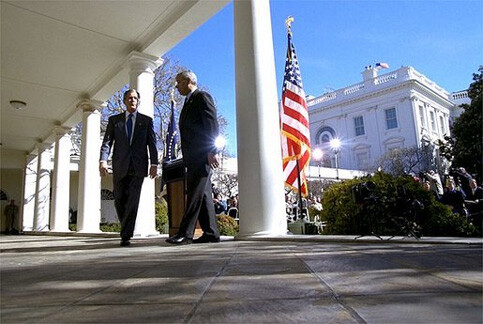The Financial Times 22 July 2003

President George W. Bush and Secretary of State Colin Powell walk back to the Oval Office after addressing the media in the Rose Garden Friday, March 14, 2003. The President discussed an outline for peace in the Middle East. (White House/Paul Morse)
Despite the declaration of a unilateral Palestinian ceasefire with Israel, and the frequent meetings between Israeli and Palestinian leaders, the “road map” for peace is in serious trouble. This is because the Bush administration, the plan’s chief sponsor, has allowed Israel to reinterpret it so that it is gutted of the elements that offered hope of progress.
Two elements distinguish the road map from the failed Oslo process. First, it requires Israel to freeze all settlement construction in the occupied territories at the outset and to remove all colonies established since March 2001. Second, the road map spells out explicitly the objective of the peace process: an end to Israel’s occupation of Palestinian territory; and two states, Palestine and Israel, living side by side.
Because Israel depends on the US for the military and diplomatic backing that allows it to continue its occupation of Arab land indefinitely, the success or failure of the plan lies in Washington’s willingness to confront an Israel that remains committed to the settlements and opposed to a genuinely independent Palestinian state.
The first signs that President George W. Bush would not follow through on his verbal commitment to the stated objectives came in his closing statement at the June 4 summit in Aqaba, Jordan, to launch the road map. While Mr Bush demanded that Mahmoud Abbas, the Palestinian prime minister, concentrate on ending any and all Palestinian resistance to Israeli occupation, he allowed Ariel Sharon, Israel’s prime minister, to commit to far less than the plan demands.
Mr Bush welcomed Mr Sharon’s “pledge to improve the humanitarian situation in the Palestinian areas and to begin removing unauthorised outposts immediately”. In this way, Mr Bush conceded to Mr Sharon the right to decide what constitutes an “unauthorised” settlement - a distinction that does not exist in international law, which is clear that all the settlements are illegal. Israel has made a great display of removing a few outposts, mostly empty trailers and water tanks. In one case, The New York Times reported a scuffle between supposedly angry settlers and Israeli soldiers removing an outpost, which was interrupted so that the antagonists could share refreshments. As these sham efforts went on, Mr Sharon told his cabinet that the settlers could continue to build but should do so quietly. The result, according to Israel’s Peace Now, a pressure group, is an increase in the number of outposts by at least two since Mr Bush made his statement.
More significantly, Israel has continued to carry out substantial construction projects in the occupied territories. It has accelerated work on a four- metre-high concrete wall that has in effect annexed large swaths of the West Bank to Israel and cut off many Palestinian towns and villages from the rest of the occupied territories.
These facts on the ground make a genuine two-state solution increasingly unattainable in practice. But, politically, the road map has already been emptied of the content that would make such an outcome possible in the first place. By recognising Israel within its 1948 borders, Palestinians have already conceded 78 per cent of historic Palestine - in which they were the overwhelming majority until Israel’s creation. In exchange, they expect full independence and sovereignty in the remaining 22 per cent - the whole of east Jerusalem, the West Bank and the Gaza Strip. In this goal, they are supported by a vast body of international law and United Nations resolutions.
Yet when Mr Sharon stated in Aqaba that “we can also reassure our Palestinian partners that we understand the importance of territorial contiguity in the West Bank for a viable Palestinian state”, he was essentially ruling out a full Israeli withdrawal. “Contiguity” is an issue only in the context of a continued Israeli presence on Palestinian land. Mr Sharon is willing to call an arrangement in which Palestinians are given limited self-government within a greater Israel where they have no civil or political rights a “state”. Many Palestinians compare it to apartheid.
These developments, along with Mr Bush’s oblique endorsement of Israel’s rejectionist position towards the right of return of Palestinian refugees, do not add up to what is desperately needed: a serious and rapid effort to end the occupation completely and restore to Palestinians the basic rights they have been denied for so long. Hence there is little to build or sustain support for the process among Palestinians.
As the Bush administration does nothing to check Israel - and simultaneously piles pressure on the deeply unpopular Mr Abbas, whose appointment as Palestinian prime minister it engineered - it is only a matter of time before the situation explodes in a new and sustained round of violence.
Perhaps the only hope of saving the process lies with strong intervention by the European Union, which nominally co-authored the road map. Hitherto, the EU has acquiesced in US leadership, even when it has disagreed with US positions. And the US has been willing to ignore Europe on those rare occasions when it has asserted itself, as the Iraq crisis demonstrated. But, ironically, US difficulties in Iraq may give Europe the leverage to demand real action towards Palestinian freedom and Middle East peace as a prerequisite for help in extricating the Americans from their own unravelling occupation of Iraq.
Hasan Abu Nimah is former ambassador and permanent representative of Jordan at the UN. Ali Abunimah is co-founder of The Electronic Intifada. This article appeared in The Financial Times on 22 July 2003.





